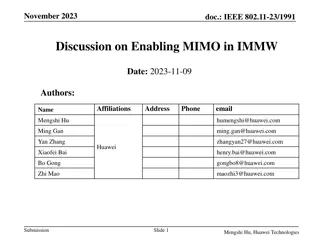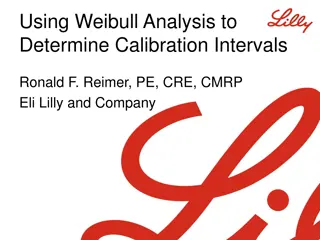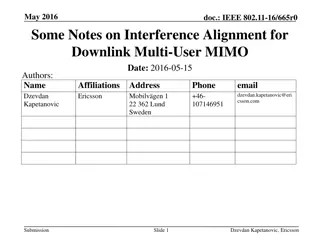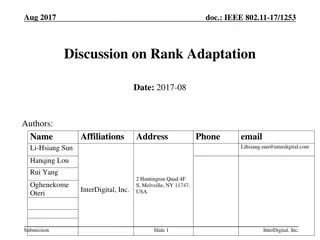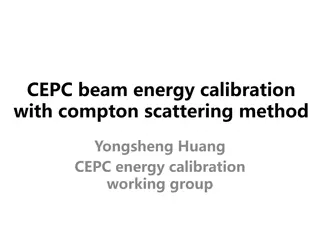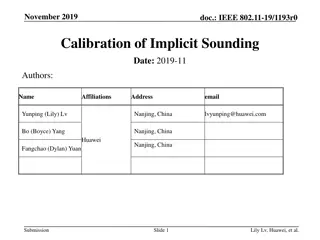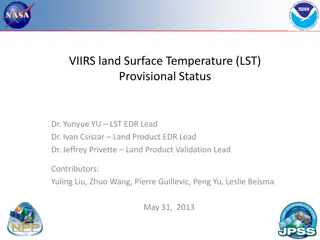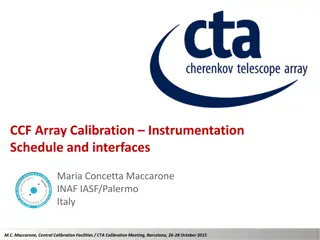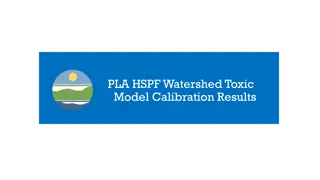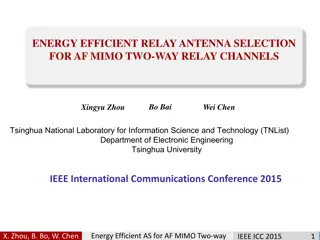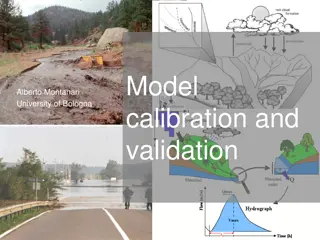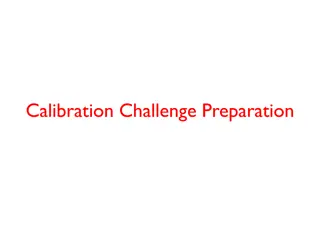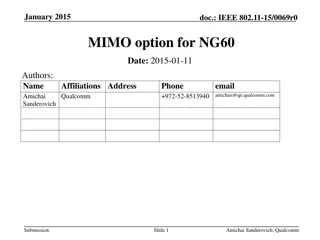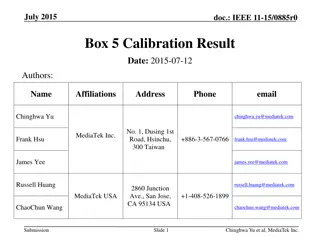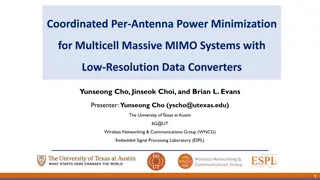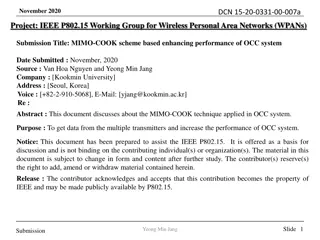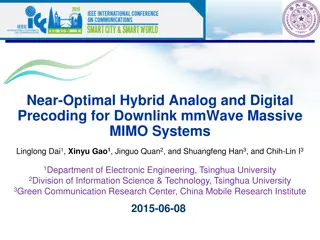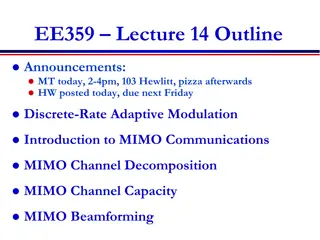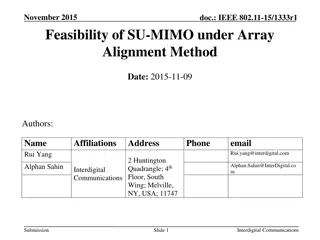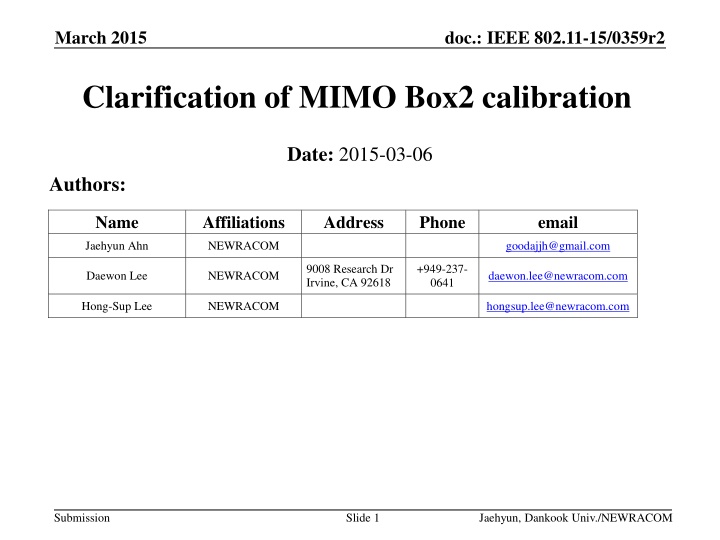
IEEE 802.11 MIMO Calibration Analysis
Explore the detailed analysis of MIMO calibration for IEEE 802.11 standards in March 2015. The document covers topics such as MIMO box calibration, per-tone SINR processing, precoding matrix decisions, MMSE receiver assumptions, and more, providing valuable insights into wireless communication standards.
Download Presentation

Please find below an Image/Link to download the presentation.
The content on the website is provided AS IS for your information and personal use only. It may not be sold, licensed, or shared on other websites without obtaining consent from the author. If you encounter any issues during the download, it is possible that the publisher has removed the file from their server.
You are allowed to download the files provided on this website for personal or commercial use, subject to the condition that they are used lawfully. All files are the property of their respective owners.
The content on the website is provided AS IS for your information and personal use only. It may not be sold, licensed, or shared on other websites without obtaining consent from the author.
E N D
Presentation Transcript
March 2015 doc.: IEEE 802.11-15/0359r2 Clarification of MIMO Box2 calibration Date: 2015-03-06 Authors: Name Affiliations Address Phone email Jaehyun Ahn NEWRACOM goodajjh@gmail.com 9008 Research Dr Irvine, CA 92618 +949-237- 0641 Daewon Lee NEWRACOM daewon.lee@newracom.com Hong-Sup Lee NEWRACOM hongsup.lee@newracom.com Submission Slide 1 Jaehyun, Dankook Univ./NEWRACOM
March 2015 doc.: IEEE 802.11-15/0359r2 MIMO Box 2 Calibration 4 Scenarios 3 test cases per scenario Test 1 (Interference free): CDF for per-tone SINR and effective SINR Test 2 (Interference only on DL): CDF for per-tone SINR and effective SINR Test 3 (CCA, Interference on DL/UL): CDF for per-tone SINR and effective SINR on DL, CDF for per-tone SINR and effective SINR on UL Channel model (Default) Scenario 1/2/3: 11n Channel model D Scenario 4: ITU UMi MIMO configuration 2x2 antenna configuration Submission Slide 2 Jaehyun, Dankook Univ./NEWRACOM
March 2015 doc.: IEEE 802.11-15/0359r2 Per-Tone Post Processing SINR For MIMO configuration, STA j in AP i k-th layer per-tone post processing SINR with linear receiver S SINR + + = w H p p H w ( k ij i i ij k jk I = w w H P P H w i m jk = ~ jk I I N jk jk jk 2 x H jk H ik H ij S jk ij ik jk ) 2 x H H H H k H ik H ij H p p H w : Co-stream interference ij ik k ~ = 2 H jk H m H mj w H P P H w I : Interference from other STAs/APs jk mj m jk x m N = 2 n H jk w w N jk jk p w : covariance 2 iP: precoding matrix : precoding matrix for k-th layer : linear receive filter jk jk Submission Slide 3 Jaehyun, Dankook Univ./NEWRACOM
March 2015 doc.: IEEE 802.11-15/0359r2 Precoding Matrix & Receiver Filter? However, current EMD [1] does not describe how to decide precoding matrix & receiver filter clearly. MIMO calibration result could be differentiated according to precoding matrix & assumptions on receiver There are few receive filter options for calibration purpose There are few precoding options for calibration purpose: Genie selection (i.e. full rank, right sided SVD matrix based on channel of the intended link only) No precoding matrix (full rank, identity matrix) Some fixed matrix Submission Slide 4 Jaehyun, Dankook Univ./NEWRACOM
March 2015 doc.: IEEE 802.11-15/0359r2 MMSE Receiver Assumption Proposed that MMSE receiver is used for calibration purpose. Proposed Baseline: jk H w = ( ) 1 + 2 H i H ij P P H H p ij i n ij ik Option 1: = + 2 2 x 2 n H m H mj H P P H I n mj m , m N m i Option 2: = + 2 n 2 x 2 n H mj H H I diag mj , m N m i Option 3: (suggested assumption for calibration) = I 2 2 n n Submission Slide 5 Jaehyun, Dankook Univ./NEWRACOM
March 2015 doc.: IEEE 802.11-15/0359r2 LSP correlation for link from STA(AP) to STA(AP) in Scenario 4 In ITU channel model, LSP (Large Scale Parameter) is correlated based on geometrical distance. And, in general, exponential filter is used to reduce calculation complexity, in which determined geometrical random values are filtered and their location is not related to number of links. However, current ITU channel model does not clearly show the correlation for link from AP to AP or from STA to STA. AP to AP seems uncorrelated circumstances since distance between AP to AP is quite big. STA to STA seems quite complex since the number of STAs is too much. How to handle this? Submission Slide 6 Jaehyun, Dankook Univ./NEWRACOM
March 2015 doc.: IEEE 802.11-15/0359r2 Conclusion Receiver filter assumption is not clear in MIMO Box 2 calibration We propose to use the most basic assumption, MMSE receive filter with only co-stream interference covariance estimation, for calibration purposes. Precoding matrix selection rule is not clear in MIMO Box 2 calibration Precoding matrix selection rule should be described in EMD For simplicity reasons, we prefer to have no precoding matrix (i.e. full rank identity matrix) for calibration. LSP correlation We need verification of the AP to STA LSP correlation and concrete description on AP to AP links and STA to STA links. To simplify the calibration, we propose the following AP to STA : LSP is correlated using distance based correlation between BS and UE in ITU UMi/UMa model AP to AP : LSP is uncorrelated STA to STA : LSP is uncorrelated However, simplified assumptions may not reflect reality well. We would like feedback from TGax members on this issue. Submission Slide 7 Jaehyun, Dankook Univ./NEWRACOM
March 2015 doc.: IEEE 802.11-15/0359r2 Straw Poll #1 What should be the receiver assumption for MIMO Box 2 calibration purposes? 1. MMSE receiver with ideal interference rejection (Option 1 in slide) 2. MMSE receiver with only co-spatial-stream interference rejection (Option 3 in slide) 3. Need further discussion Submission Slide 8 Jaehyun, Dankook Univ./NEWRACOM
March 2015 doc.: IEEE 802.11-15/0359r2 Straw Poll #2 What should be the precoding matrix assumption for MIMO Box 2 calibration purposes? 1. No precoding (i.e. full rank transmission with identity matrix as precoding matrix) Genie precoding (i.e. full rank transmission with right sided SVD matrix based on channel matrix of the intended signal link) Something else (e.g. some fixed precoding rank 1 vector) Need further discussions 2. 3. 4. Submission Slide 9 Jaehyun, Dankook Univ./NEWRACOM
March 2015 doc.: IEEE 802.11-15/0359r2 Straw poll #3 What is the current understanding of the LSP correlation conditions between AP to STA for MIMO Box 2? 1. Distance based correlation (based on ITU M.2135 correlation between Base Station and User Terminal Uncorrelated Undefined in the EMD and therefore interpretation left up to each individual contributor 2. 3. Submission Slide 10 Jaehyun, Dankook Univ./NEWRACOM
March 2015 doc.: IEEE 802.11-15/0359r2 Straw Poll #4 What should be the LSP correlation conditions for MIMO Box 2? For options with correlation, the assumption is that correlation shall be based on the distance-based-correlation defined for BS and UT in ITU M.2135 1. AP to AP uncorrelated & STA to STA uncorrelated 2. AP to AP correlated & STA to STA correlated 3. AP to AP uncorrelated & STA to STA correlated 4. AP to AP correlated & STA to STA uncorrelated 5. Need further discussions Submission Slide 11 Jaehyun, Dankook Univ./NEWRACOM
March 2015 doc.: IEEE 802.11-15/0359r2 References [1] https://mentor.ieee.org/802.11/dcn/15/11-14-0571-07- 00ax-evaluation-methodology.docx Submission Slide 12 Jaehyun, Dankook Univ./NEWRACOM


